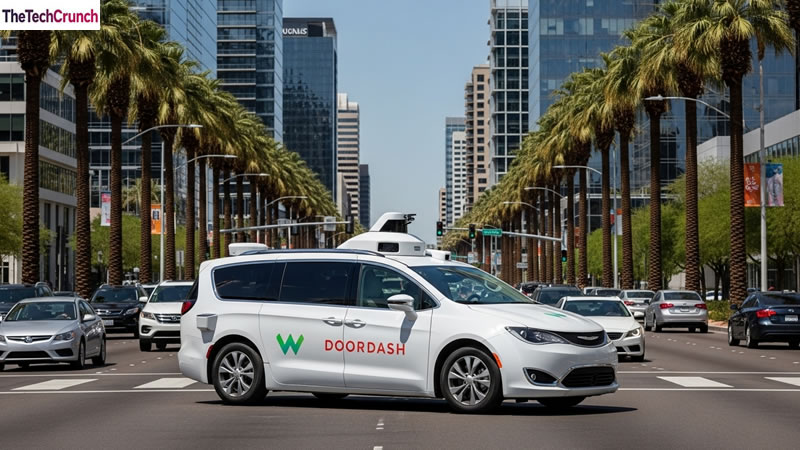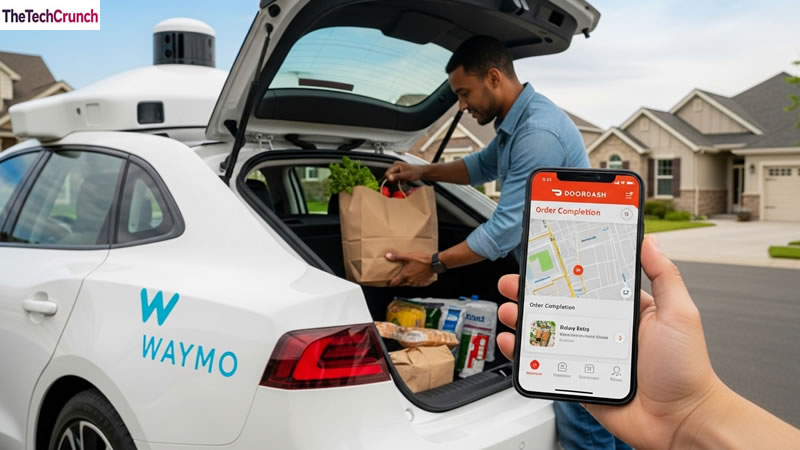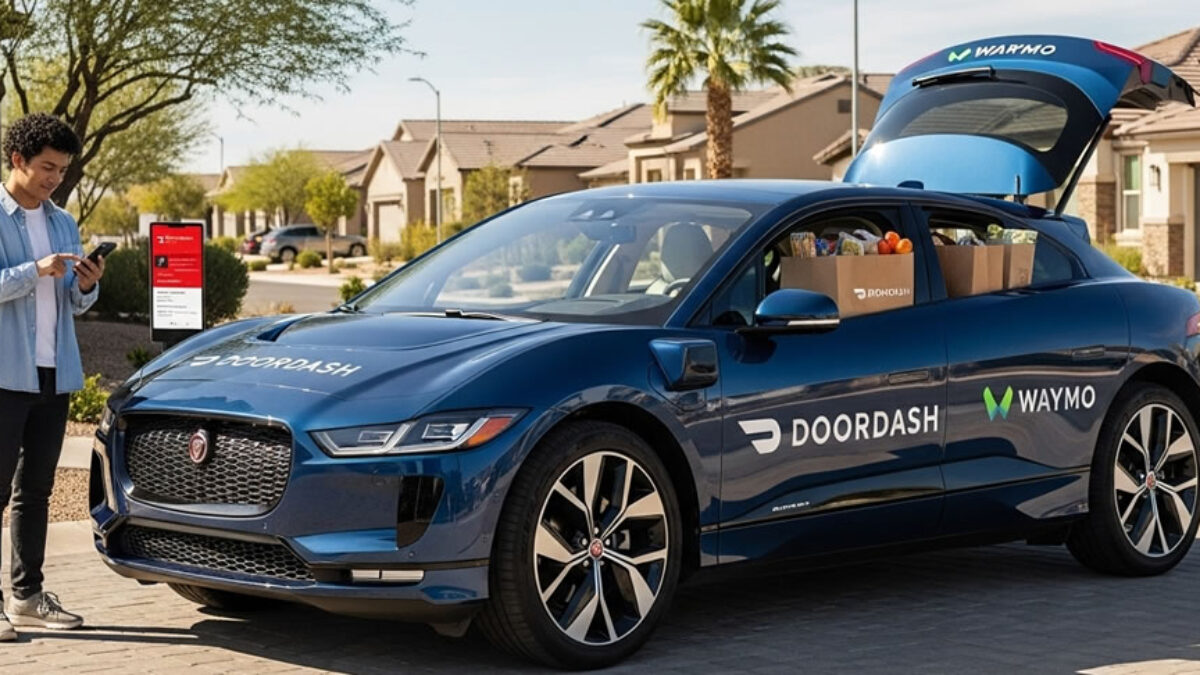The partnership between Waymo and DoorDash marks a groundbreaking step in the evolution of autonomous delivery. As cities grow larger and consumer demand for faster, more convenient services increases, the integration of self-driving technology into delivery networks is becoming not only innovative but necessary.
Stay up to date with the latest technology in TheTechCrunch. This covers artificial intelligence, mobile and web apps, modern things, cybersecurity, and general technical news. From AI’s successes to chat and generative tools. Such as smartphones, laptops, and wearables’ special reviews. TheTechCrunch gives an insight into this case.
Waymo, an Alphabet-owned company known for its advanced self-driving vehicles, has teamed up with DoorDash to test and refine how autonomous vehicles can deliver groceries and food to real customers in Phoenix, Arizona. This collaboration reflects both companies’ commitment to shaping the future of local commerce through automation and artificial intelligence.
A Brief Background on Waymo’s Journey
Waymo began as a project under Google in 2009 with a mission to make transportation safer and more accessible through autonomous technology. Over the years, Waymo has transformed from an experimental research initiative into one of the leading names in the self-driving industry.

The company’s robotaxi services, known as Waymo One, have been operating in parts of Phoenix since 2020, serving thousands of riders without a human driver. Beyond passenger transport, Waymo also experimented with logistics and delivery through a division called Waymo Via. This arm focused on self-driving trucks and partnerships with logistics companies like UPS and Uber Eats.
However, in 2023, Waymo decided to pause its trucking program to focus on scaling its robotaxi operations. Despite this shift, the company’s experience in delivery logistics laid the foundation for its newest collaboration — the Waymo DoorDash partnership.
DoorDash’s Autonomous Ambitions
DoorDash, one of the largest food delivery platforms in the United States, has long explored automation as a way to enhance efficiency and reduce costs. The company has already worked with Serve Robotics, a startup developing sidewalk delivery bots, in Los Angeles. It also has an in-house robotics division that recently developed an autonomous delivery bot called Dot, which is currently being tested in the Phoenix area.
DoorDash’s interest in autonomous delivery aligns with its broader goal of creating a multi-modal delivery ecosystem — one that includes drivers, robots, drones, and now, self-driving cars. According to David Richter, Vice President of Business and Corporate Development at DoorDash, partnering with Waymo offers customers a “new and delightful experience” while helping the company move toward a more sustainable and efficient delivery model.
How the Waymo DoorDash Partnership Works
Under this new partnership, customers in Phoenix who place orders through DoorDash may have their deliveries fulfilled by a Waymo autonomous vehicle. These self-driving cars, specifically Jaguar I-Pace electric SUVs equipped with Waymo’s advanced AI and sensor technology, will transport groceries and food within a 315-square-mile area of the city.
Initially, the service will focus on deliveries from DashMart, DoorDash’s convenience and grocery stores. Over time, the program will expand to include more local merchants and a wider variety of products. Not every DoorDash order will be handled by a Waymo vehicle — the rollout will be gradual as both companies collect data, monitor customer feedback, and refine the process.
When a delivery is assigned to a Waymo car, the items will be placed in the vehicle’s trunk. Once the car arrives at the destination, the customer will receive a notification via the DoorDash app and retrieve the order from the trunk. While this process removes the traditional handoff from a human courier, it represents an important test of how users adapt to interacting with fully autonomous systems in everyday scenarios.
Testing the Future of Convenience
The Phoenix metropolitan area has become a key testing ground for autonomous technology, and this partnership is a continuation of that trend. Both companies are observing how customers respond to the self-service delivery model — where the convenience of automation must balance against the small effort required from customers to pick up their items themselves.
This human-free handoff process will provide valuable insights into consumer behavior. Do customers value the novelty and efficiency of autonomous delivery enough to step outside and retrieve their order? Or will they prefer the convenience of traditional human delivery? These are the questions Waymo and DoorDash aim to answer through this collaboration.
The Technology Behind the Partnership
Waymo’s vehicles are equipped with a powerful combination of lidar sensors, cameras, radar, and artificial intelligence algorithms that allow them to navigate complex city streets without human input. These cars can detect pedestrians, cyclists, and other vehicles, making real-time decisions to ensure safety and efficiency.

The software constantly learns from millions of miles driven in both real-world and simulated environments. This learning capability allows Waymo vehicles to adapt to local traffic conditions and unique city layouts, such as Phoenix’s wide streets and high-speed intersections. DoorDash, on the other hand, contributes its expertise in logistics, order management, and customer service, ensuring a seamless experience from order placement to final delivery.
Economic and Environmental Benefits
The Waymo DoorDash partnership is not just about innovation — it also has potential economic and environmental advantages. By reducing the need for human drivers in certain scenarios, DoorDash can lower operational costs and increase delivery efficiency. Autonomous vehicles can operate for longer hours without breaks, ensuring consistent service even during peak demand times.
From an environmental standpoint, Waymo’s electric vehicles contribute to lower emissions compared to traditional delivery cars. This aligns with both companies’ sustainability goals and the growing demand for eco-friendly business practices.
Challenges and Future Outlook
While the partnership holds great promise, it also comes with challenges. The biggest hurdle is customer adoption. People are still adapting to the idea of interacting with driverless vehicles, and any technical issue or delay could influence their perception. Additionally, regulations surrounding autonomous vehicles continue to evolve, meaning widespread deployment will require ongoing coordination with local governments and transportation authorities.
Explore a complete hub for the latest apps. Smart things and security updates online. Ranging from AI-operated solutions and automation tools. TheTechCrunch offers in-depth articles, comparisons. And specialist analysis is designed to understand the rapidly changing technology. Whether you are keen on robotics, data protection, or the latest digital trends.
Despite these challenges, both Waymo and DoorDash remain optimistic. The partnership represents a critical step toward building trust and proving that autonomous delivery is not just a futuristic concept but a viable, scalable service.
TheTechCrunch: Conclusion
The Waymo DoorDash partnership symbolizes the convergence of technology, innovation, and convenience in modern commerce. It demonstrates how two industry leaders are working together to redefine what local delivery can look like in the coming years. By leveraging autonomous vehicles, they aim to create a smarter, safer, and more sustainable delivery network.
As testing continues in Phoenix and expands to other regions, this partnership could set a new standard for how consumers interact with technology in their daily lives — a future where food, groceries, and goods arrive quietly and efficiently, powered entirely by artificial intelligence.
Here Are More Helpful Articles You Can Explore On TheTechCrunch:
- Reddit Expands Its AI-Powered Search To Five New Languages
- General Intuition AI: Pioneering the Future of Spatial-Temporal Reasoning
- Pinterest AI Slop: How the Platform Is Tackling the Surge of AI-Generated Content
- Spotify SongDNA: Explore Who Makes Your Music
- Best AI Automation Tools for Small Business Growth
- Google Search and Discover Updates 2025
- Spotify Managed Accounts: A New Way for Parents to Control What Their Kids Listen To


